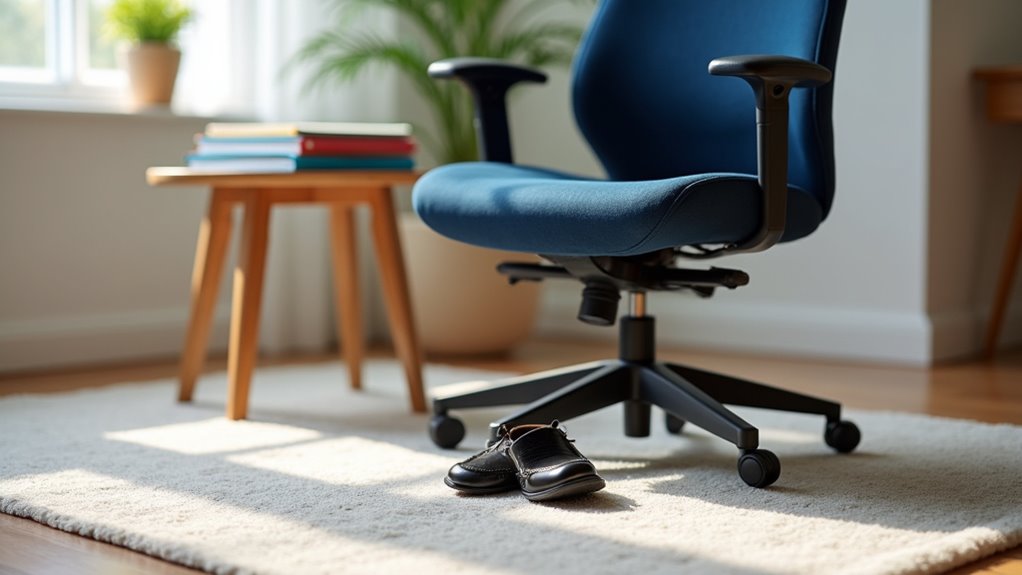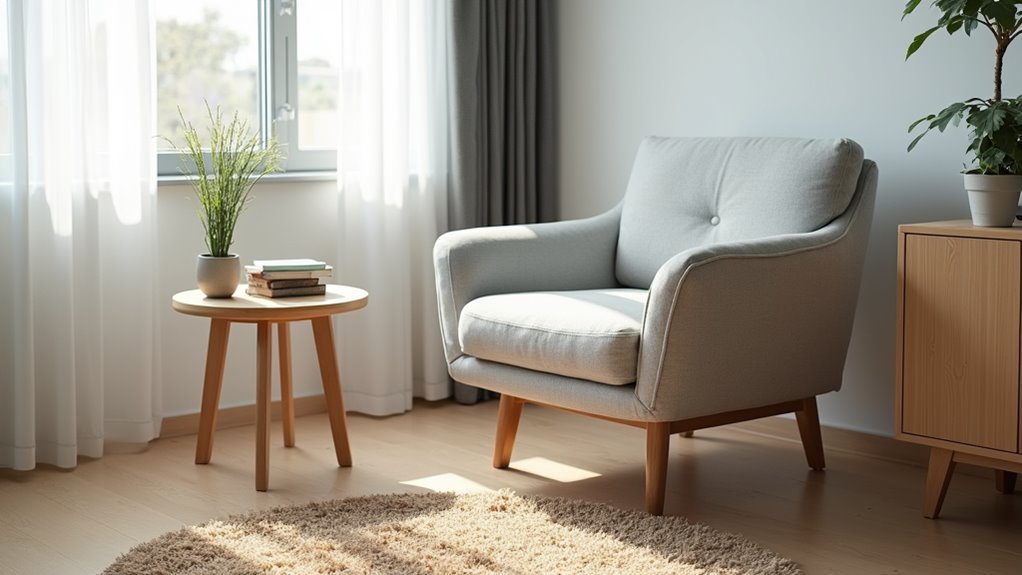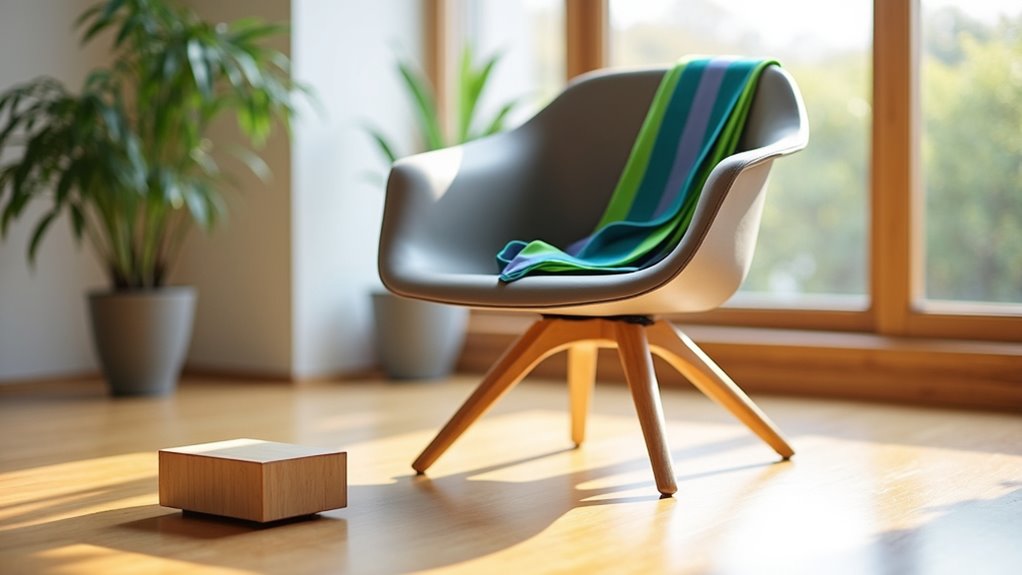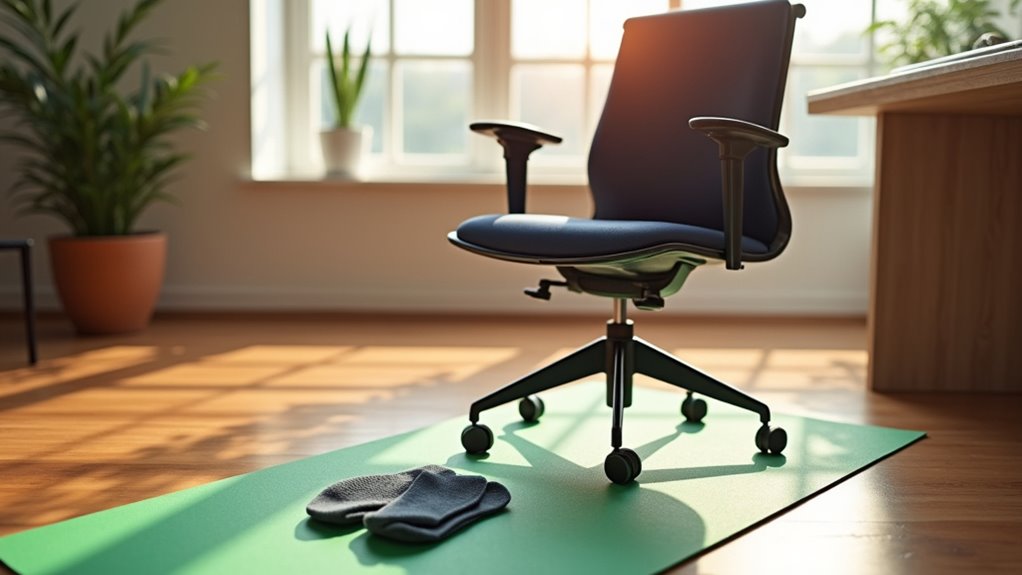How to Properly Stand up From a Chair
This post contains affiliate links. As an Amazon Associate, we earn from qualifying purchases.
To stand up from a chair efficiently, scoot to the front edge, keep your feet flat and shoulder-width apart, and lean forward slightly. Engage your core and push up through your legs, using your arms for balance if necessary. If your chair has armrests, utilize them for added support. With practice, you’ll soon rise effortlessly. For those seeking more detailed guidance and tips, continue reading for further insights on standing confidently!
Essential Facts in 30 Seconds
- Sit at the front edge of the chair with feet flat and shoulder-width apart.
- Lean forward from the hips while keeping your back straight.
- Engage core muscles and push up with your legs to reduce back strain.
- Use a rocking motion, leaning your nose over your toes for momentum.
- Practice regularly to enhance standing technique and mobility.
Preparing to Stand Up
Stand up like a champ with these simple techniques!
Start with a chair about 17 inches high and without armrests. This helps you get up easily. Sit at the front edge, halfway on the seat. Keep your feet flat on the floor and shoulder-width apart. This position sets you up for success. Having a supportive chair can significantly enhance your ability to stand up effortlessly.
Lean forward from your hips. Keep your back straight. Picture your nose trying to peek over your toes. Your feet stay grounded, ready to push off. Engage your core muscles for stability. The Chair Stand Test is an efficient way to measure your progress as you practice these techniques.
Stand up smoothly and don’t rush. Avoid plopping down like a sack of potatoes!
Practice these steps. With time, you’ll be standing tall and proud. Great job on your effort, future chair conqueror!
Correct Body Mechanics

Standing up from a chair can be easy with the right body mechanics. Good posture and alignment are very important. Bend at your hips and knees, not your waist. This protects your lower back and promotes proper sitting posture during your time at the desk. Engaging your core muscles to keep your spine stable is crucial, as it helps maintain proper positioning while seated. Additionally, ensuring that your chair is adjusted correctly can further support proper sitting position when you are seated. Keep your feet shoulder-width apart for balance. Proper setup for sit to stand is essential to ensure a smooth transition.
Follow this simple guide:
| Step | What to Do | Why It Matters |
|---|---|---|
| Start Position | Sit up straight, feet flat | Maintains spinal alignment |
| Bend Hips/Knees | Lower yourself smoothly | Reduces strain on your back |
| Engage Core | Tighten your abs | Stabilizes your spine |
| Push Up | Use your legs to stand | Protects your back during lift |
| Keep Feet Stable | Feet shoulder-width apart | Creates a strong base of support |
Use these tips to stand up confidently!
Utilizing Momentum and Balance
Using momentum and balance helps you stand up smoothly.
First, lean your nose over your toes. This move shifts your center of mass forward. It makes lifting off much easier.
Rock a bit before you rise. Think of it as revving up an engine. This extra boost helps you stand without bumps or wobbles.
Focus on your balance. Keep your feet shoulder-width apart. This stance gives you a solid base. Use your arms for support. Swing them gently for extra help. Additionally, utilizing a rollator support can enhance your stability during the standing process, especially for those with muscle weakness.
Practice this method daily. It makes standing up easier. Soon, you’ll do it without thinking.
Enjoy the freedom of moving smoothly!
Nose Over Toes Technique
Get ready to master the chair-to-stand move! Start by sitting at the edge of your chair. Your nose should be right over your toes for proper alignment.
Keep your feet flat and hip-width apart. This gives you better balance. Lean forward a little from your hips. Stick your bottom out slightly. This helps you stay steady—no leaning back!
Now, push through your heels. Stand up smoothly. Use the armrests if you need support. Keep it controlled to avoid falling.
You can do this! Stand tall and proud!
Rocking Motion for Momentum
Sitting at the edge of your chair and leaning forward helps you start.
To really boost your movement, add a rocking motion. Lean slightly forward, then rock back and forth. This builds momentum. As you rock, feel your weight shift from your seat to your feet. This gentle push-off helps you stand up.
Keep your core tight for balance. With practice, standing will feel easy. A sturdy chair supports you well. Looking straight ahead keeps you steady.
Let’s rock and roll!
Choosing the Right Chair and Environment

Pick a chair that’s stable and firm. A wobbly chair can be dangerous.
The seat height matters. Your feet should rest flat on the floor. Keep your knees at a comfy 90-degree angle. An ergonomic chair can significantly enhance your sitting posture and comfort. A chair with proper height adjustment mechanisms can further improve your alignment and reduce discomfort.
Armrests are important too. They give your arms a break. They also help you stand up easily.
A good chair makes sitting better. It can help you focus and feel good. Proper chair height adjustment is essential for overall comfort and support.
Choose wisely for comfort and support.
Chair Stability and Firmness
A good chair makes a big difference for comfort and stability. Here’s how to test for chair stability and firmness:
- A strong base is key. Pick a chair with five wheels for better balance.
- Strong materials matter. Steel chairs resist bending and last longer.
- Test the seat’s firmness. It should feel supportive, not saggy or soft, as proper seat depth consideration is crucial for comfort. Additionally, correct sitting posture promotes overall health and reduces strain on your body.
- Check the wheels. Make sure they match your floor type. Soft floors need special casters to avoid sliding.
Finding the right chair helps you stand up easily and stay comfortable. Additionally, ensuring proper chair height adjustment is essential to maintain good posture while seated.
Optimal Seat Height
Finding the right seat height can make a big difference in comfort and productivity. Aim for a seat that lets your knees bend at a 90-degree angle. Your feet should rest flat on the floor. Properly adjusted chair height can significantly improve posture and overall sitting experience. Chair height adjustment is crucial for maintaining comfort during long hours at a desk.
For people who are 4’11” to 5’2″, a chair height of 14-16 inches works best. Those between 5’3″ and 5’10” should choose a height of 16-19 inches. Taller individuals, over 5’10”, need a chair height of 21-22 inches.
Adjustable chairs are great. They let you change the height to fit your desk and work style. Proper chair height enhances comfort and productivity during work hours.
The right seat height helps you stay comfortable and focused. It also provides important ergonomic benefits. Choose wisely!
Armrests for Support
Armrests play a key role in making your chair comfortable and help when you stand up. Here are tips for picking the best armrests:
- Adjustable Armrests: Find armrests that can change height and width. This helps fit different body sizes and makes sitting more comfortable. Properly adjusted armrests can also help maintain correct sitting posture throughout the day. Additionally, optimal positioning of armrests can further enhance your overall comfort while seated.
- Materials: Pick armrests that are cushioned and made from strong materials. They should be easy to clean and provide firm support without causing discomfort.
- Support: Good armrests let your shoulders relax. They also make it easier to push yourself up when standing.
- Desk Fit: Adjustable armrests slide under desks easily. This keeps your workspace tidy and efficient.
Additionally, consider how proper height can prevent discomfort during prolonged sitting, which also improves the overall experience of using armrests.
Choose wisely to enhance your seating experience!
Exercises to Enhance Standing Ability

Boost your standing abilities today! Sit-to-stand exercises and balance routines can make a big difference. These fun activities will strengthen your legs and improve your balance. Proper sitting posture is essential for maintaining overall body alignment and making transitions easier. Chair yoga, for instance, can also enhance flexibility and range of motion as you work on standing up from a seated position.
| Exercise | Description |
|---|---|
| Sit-to-Stand | Stand up from a chair. Use your arms for balance. |
| Single Limb Stance | Lift one foot. Hold for one minute. |
| Heel to Toe | Walk with your heel touching your toes. |
| Side Leg Raises | Lift one leg sideways while standing. |
| Farmer’s Walk | Carry weights while walking around. |
Aim for 2-3 sets of 10 repetitions daily for sit-to-stand. These exercises help you feel strong and confident. Soon, you’ll stand up easily—like a superhero! Keep practicing and feel the difference. Let’s get moving!
Safety Precautions and Recommendations

Standing up from a chair safely is important for everyone. Follow these simple tips to help prevent falls and feel confident:
- Slide forward: Move to the edge of the chair. This makes standing easier.
- Feet flat: Place your feet shoulder-width apart. Keep your strong foot slightly in front.
- Arm power: Use the armrests or your thighs for support. They help you push up.
- Look ahead: Keep your eyes forward. This helps you stay balanced.
Use safety gear like grab bars or sturdy chairs if needed. Regular cleaning of your chair can also enhance stability and comfort, as maintaining hygiene and mobility is crucial for safe usage.
Practice these steps often. With time, you’ll stand up safely and confidently. Great job taking action!
Frequently Asked Questions
Can I Stand up Without Using My Hands?
Standing up without using your hands is possible with practice. Focus on balance techniques to help. A stable chair can make a big difference. Sit at the edge of the chair to shift your weight forward. This helps your body rise up more easily.
Strengthening your legs also helps. Try simple exercises like leg lifts or squats. These build muscle and improve balance.
Use your core muscles for support. They help you stay steady as you stand.
Practice regularly. With time, you will feel more confident getting up without using your hands.
What Should I Do if I Feel Dizzy?
Feeling dizzy can be scary. Don’t let panic take over. First, find a safe place to sit. This helps you avoid falls and injuries. Take deep breaths to calm down. Slow movements are key. Shift your position gently.
Stay hydrated too. Drink water, as dehydration can cause dizziness. Eating small snacks can help as well.
Keep track of your dizziness. Note when it happens and what you were doing. This information can help your doctor.
See a healthcare professional if dizziness does not improve or gets worse. They can check for any serious issues. Remember, your health is important. Take care of yourself!
How Can I Practice Standing up Safely Alone?
Practice standing safely alone by doing balance exercises. Use a sturdy chair to help. Make sure your chair does not wobble. Armrests can give you extra support. Strong core muscles help you stand better. Regular practice boosts your confidence and strength. Over time, you will stand more easily and independently. Keep trying, and you will improve. Stay safe and enjoy your progress!
Is It Normal to Struggle Standing up Sometimes?
Struggling to stand sometimes is common. Many people face this, especially as they get older. It can happen due to weak muscles or poor balance. These two things make standing harder.
Regular exercise helps build strength and improve balance. Simple activities like walking or stretching can make a big difference. If standing difficulties keep happening, talking to a doctor is a good idea. They can check for any underlying issues. Taking action can lead to better mobility and a more active life.
Can Standing up Help With My Overall Fitness?
Standing up regularly boosts your overall fitness. It builds strength and improves muscle endurance. Standing helps with balance too. This reduces the risk of falls. Adding standing to your day is a smart choice. Simple changes can make a big difference. Try standing while on the phone or during meetings. Small actions add up. Your body will thank you for it.
Conclusion
Standing up from a chair is important for staying active. About 25% of adults over 65 fall each year. Using the right techniques can help you avoid falls. Start by placing your feet flat on the ground. Lean slightly forward. Push up with your legs to stand. With practice, you will stand up easily. Keep working on these techniques. Soon, you will feel confident moving around. Staying active is key to feeling good!
